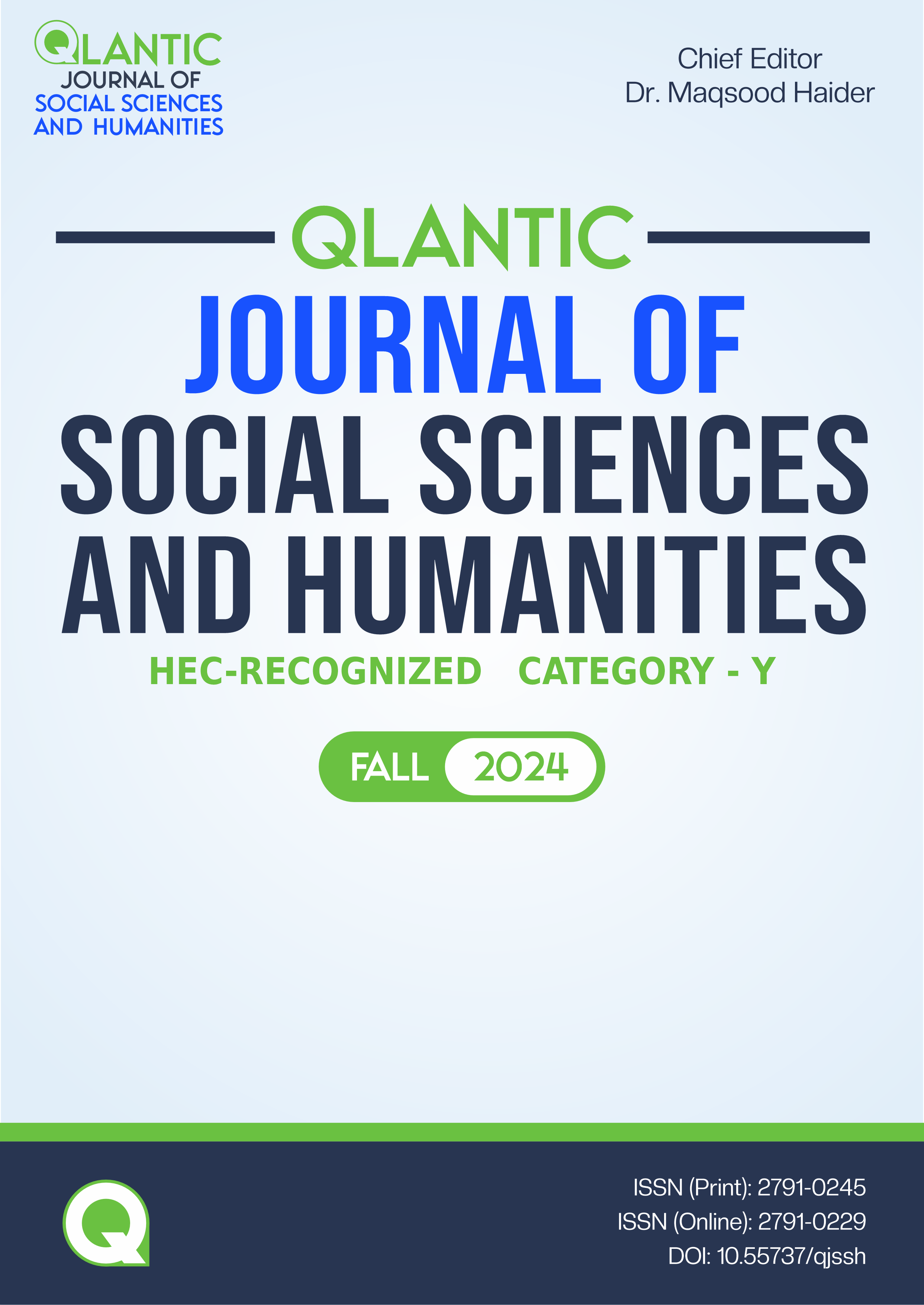Empirical Analysis of the Effectiveness of Fiscal and Monetary Policy Tools in Stabilizing Economy: Evidence from Pakistan
DOI:
https://doi.org/10.55737/qjssh.v-iv.24264Keywords:
Fiscal Policy, Monetary Policy, Vector Autoregressive Model, Impulse Response Function, Macroeconomic Stability, PakistanAbstract
Fiscal and monetary policy plays a vital role in macroeconomic stability. The Keynesians have emphasized the fiscal policy whereas the Monetarists supported interventions under monetary policy. In fact, these policies are interrelated and influence each other. The expansionary fiscal policy overheats the economy and reduce the effectiveness of monetary policy. The use of the appropriate mix of tools under fiscal and monetary policy is of immense importance for economic stability under country specific economic conditions. Therefore, the instant study was meant to look at the effectiveness of monetary and fiscal policy instruments in stabilization of Pakistan’s economy. The data was collected from secondary sources of Government of Pakistan from 1986 to 2022. The government expenditure was analyzed to be a proxy for fiscal policy whereas money supply for monetary policy. The study employed Impulse Response Function (IRF) and Variance Decomposition (VDC) in Vector Autoregressive (VAR) Model. The findings of IRF confirmed the impact of money supply on economic growth in Pakistan. At first, the money supply affected the GDP negatively but after 3rd year, its impact was changed to be positive and it was rising sharply. It indicated that the expansionary monetary policy was effective in the medium and long run in Pakistan. It was concluded that the fiscal policy appeared to be relatively more effective for its contribution towards economic growth as compared with monetary policy.
References
Adeeb, B., Saeed, S., & Ali, F. (2013). Do Fiscal, monetary and trade policies matter for growth? Empirical evidence from Pakistan (Doctoral dissertation, Dissertation, Mohammad Ali Jinnah University, Islamabad).
Aghion, P., Caroli, E., & García-Peñalosa, C. (1999). Inequality and Economic Growth: The Perspective of the New Growth Theories. Journal of Economic Literature, 37(4), 1615–1660. https://doi.org/10.1257/jel.37.4.1615
Andersen, L. C., & Jordan, J. L. (1968). Monetary and Fiscal Actions: A Test of Their Relative Importance in Economic Stabilization. Review, 50, 11–24. https://doi.org/10.20955/r.50.11-24.qox
Arrow, K. J. (2017). Optimal capital policy with irreversible investment. In Value, capital and growth (pp. 1-20). Routledge.
Atif, M., Shahab, S., & Mahmood, M. T. (2012). The nexus between economic growth, investment and taxes: Empirical evidence from Pakistan. Academic Research International, 3(2), 530-537. http://www.savap.org.pk/journals/ARInt./Vol.3(2)/2012(3.2-66).pdf
Blanchard, O., & Perotti, R. (2002). An Empirical Characterization of the Dynamic Effects of Changes in Government Spending and Taxes on Output. The Quarterly Journal of Economics, 117(4), 1329–1368. https://doi.org/10.1162/003355302320935043
Caballero, R. J. (1991). On the Sign of the Investment-Uncertainty Relationship. The American Economic Review, 81(1), 279–288. http://www.jstor.org/stable/2006800
CHAUDHARY, M. A., & SHABBIR, G. (2005). MACROECONOMIC IMPACTS OF BUDGET DEFICIT ON PAKISTAN’S FOREIGN SECTOR. Pakistan Economic and Social Review, 43(2), 185–198. http://www.jstor.org/stable/25825272
Chowdhury, L. S., & Afzal, M. N. I. (2015). The Effectiveness of Monetary Policy and Fiscal Policy in Bangladesh. Journal of Applied Business & Economics, 17(1). http://www.na-businesspress.com/JABE/ChowdhuryLS_Web17_1_.pdf
Fatas, A., & Mihov, I. (2003). The Case for Restricting Fiscal Policy Discretion. The Quarterly Journal of Economics, 118(4), 1419–1447. https://doi.org/10.1162/003355303322552838
Friedman, B. M. (2008). Why a Dual Mandate is Right for Monetary Policy*. International Finance, 11(2), 153–165. https://doi.org/10.1111/j.1468-2362.2008.01220.x
Government of Pakistan (2023). Economic Survey of Pakistan (Various issues), Finance Division, Islamabad.
Government of Pakistan (2023). National Accounts, Pakistan Bureau of Statistics, Ministry of Planning, Development and Special Initiative, Islamabad.
Ivanov, V., & Kilian, L. (2005). A Practitioner’s Guide to Lag Order Selection For VAR Impulse Response Analysis. Studies in Nonlinear Dynamics & Econometrics, 9(1). https://doi.org/10.2202/1558-3708.1219
Jawaid, S. T., Arif, I., & Naeemullah, S. M. (2010). Comparative analysis of monetary and fiscal policy: A case study of Pakistan. Nice Research Journal , 3(1), 58-67. https://mpra.ub.uni-muenchen.de/id/eprint/30850
Keran, M. W. (1969). Monetary and Fiscal Influences on Economic Activity—The Historical Evidence. Review, 51, 5–24. https://doi.org/10.20955/r.51.5-24.atu
Kneller, R., Bleaney, M. F., & Gemmell, N. (1999). Fiscal policy and growth: evidence from OECD countries. Journal of Public Economics, 74(2), 171–190. https://doi.org/10.1016/s0047-2727(99)00022-5
Lucas, R. E. (1972). Expectations and the neutrality of money. Journal of Economic Theory, 4(2), 103–124. https://doi.org/10.1016/0022-0531(72)90142-1
MacKinnon, J. G. (2010). Critical values for cointegration tests (No. 1227). Queen's Economics Department Working Paper, 1-17
Mankiw, N. G. (Ed.). (2007). Monetary policy. National Bureau of Economics Research Studies in Business Cycles, Vol – 29, University of Chicago Press, Chicago and London.
Mishkin, F. S. (1996). Understanding financial crises: a developing country perspective. Working Paper Series, National Bureau of Economic Research, Massachusetts. https://doi.org/10.3386/w5600
Mountford, A., & Uhlig, H. (2009). What are the effects of fiscal policy shocks? Journal of Applied Econometrics, 24(6), 960–992. https://doi.org/10.1002/jae.1079
Olaloye, A. O., & Ikhide, S. I. (1995). Economic sustainability and the role of fiscal and monetary policies in a depressed economy: The case of Nigeria. Sustainable Development, 3(2), 89–100. https://doi.org/10.1002/sd.3460030206
Pastor, L., & Veronesi, P. (2012). Uncertainty about Government Policy and Stock Prices. The Journal of Finance, 67(4), 1219–1264. https://doi.org/10.1111/j.1540-6261.2012.01746.x
Rakić, B., & Rađenović, T. (2013). The Effectiveness of Monetary and Fiscal Policy in Serbia. Industrija, 41(2). https://doi.org/10.5937/industrija41-4011
Sims, C. A. (1980). Macroeconomics and reality. Econometrica, 48(1), 1. https://doi.org/10.2307/1912017
State Bank of Pakistan (1956). The State Bank of Pakistan Act, 1956, Government of Pakistan. https://www.sbp.org.pk/about/act/SBP-Act.pdf
Stock, J. H., & Watson, M. W. (2001). Vector Autoregressions. Journal of Economic Perspectives, 15(4), 101–115. https://doi.org/10.1257/jep.15.4.101
Teigen, R. L. (1975). Monetary and Fiscal Influences on Economic Activity: Evidence from Denmark, Finland and Norway. The Swedish Journal of Economics, 77(2), 149. https://doi.org/10.2307/3438913
Downloads
Published
Issue
Section
License
Copyright (c) 2024 Dr. Bushra Pervaiz, Dr. Muhammad Qasim Manzoor, Rana Hamza Gull, Hafiza Asar Umar

This work is licensed under a Creative Commons Attribution-NonCommercial 4.0 International License.





